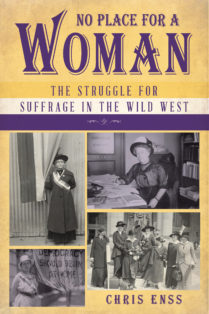Enter now to win a copy of the new book
No Place for a Woman: The Fight for Suffrage in the Wild West.

On April 5, 1895, the lavish Grand Opera House in Salt Lake City was filled to overflowing with a host of well-dressed ladies and gentlemen. Women engaged in serious discussions outnumbered the men filtering into the building. Musicians in the orchestra pit serenaded the preoccupied crowd standing, talking, and preparing to sit upon rows of waiting chairs. As the clock approached two o’clock in the afternoon, more than a dozen women filtered on stage and took their places among the plush seats stationed in front of a magnificent, hand-painted drop curtain. Conversations quieted, and the room slowly came to order. When the music faded, Mrs. J. A. Froiseth called the meeting of suffragists in the Utah Territory to order. The following articles were read to the audience.
“Whereas, a convention is being held in this city for the purpose of framing a constitution for the proposed state of Utah, and; whereas, the question is being considered by said convention of incorporating in said constitution a provision for women suffrage, and; whereas, no opportunity has been afforded the women of this Territory to manifest their opinion upon the matter; and whereas, by the adoption of a plank of favor of woman suffrage in the platforms of both political parties, no opportunity was afforded to the citizens of this Territory to indicate their approval or disapproval of the proposition, and; whereas, it is conceded alike by the advocates and the opponents of woman suffrage that in all intellectual attributes and attainments the women are entitled to vote, and if this is true, then they possess the necessary intelligence and attainments to enable them to determine for themselves whether they desire this privilege, and they should be given the opportunity to decide this question for themselves.”
The crowd of onlookers cheered and applauded the articles read aloud. They waved their hands in the air approvingly and congratulated one another for their dedication to the cause. Someone shouted, “Give me suffrage or give me nothing.” That single voice then led many in a chant of “Give me suffrage or give me nothing!”
An enthusiastic supporter of the cause leapt to her feet and proclaimed, “The fight is still on!” Fellow believers praised the sentiment. “Ninety percent of the people hesitate to try the experiment these men would force upon us,” the spontaneous orator announced. “You who propose to vote against statehood make your voice heard now, with no uncertain sound. If we are to have equal suffrage, let us have it equal. Let the women serve on juries, let them work their poll tax on the roads, make them subject to military service, let them be drafted and enlisted in time of war, let them be equal in all things!”
More than twenty-five years prior to the enthusiastic gathering at the Grand Opera House where women argued for their right to vote, a somber group of leaders in the Utah Territorial Legislature quietly passed an act giving women that entitlement. Sarah Young, grandniece of settler and Mormon Church leader Brigham Young, became the first women to vote in the region. She voted in a municipal election on February 14, 1869.

To learn more about how women won the right to vote in the West read
No Place for a Woman

